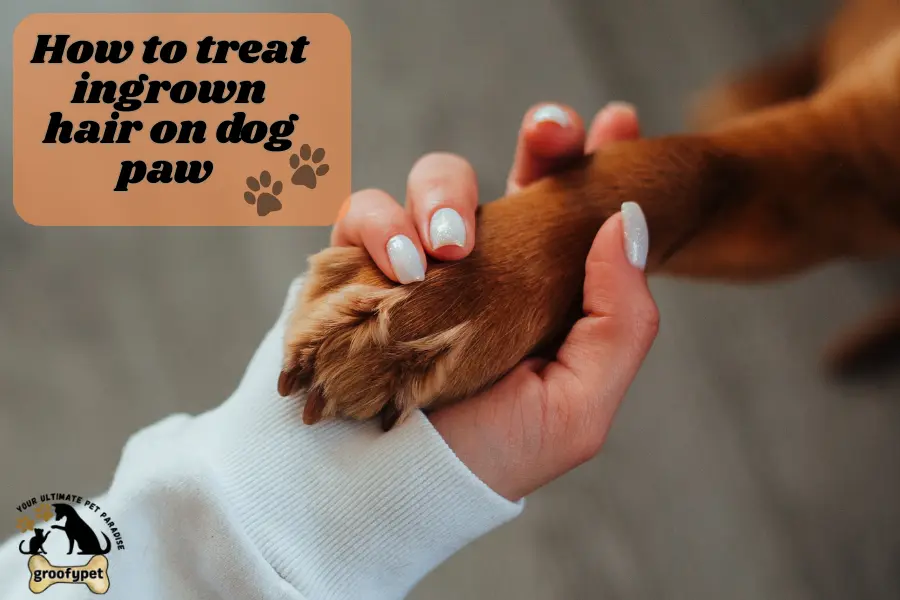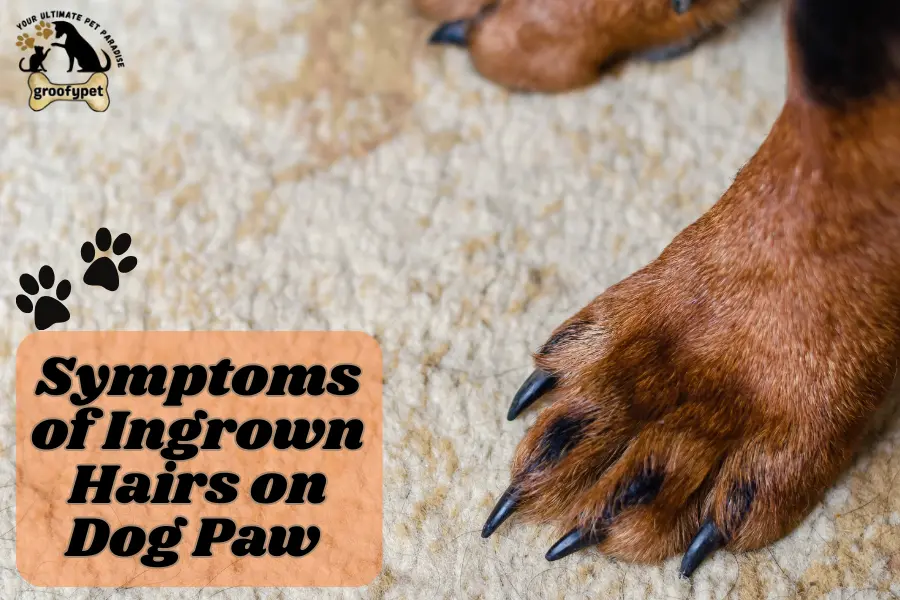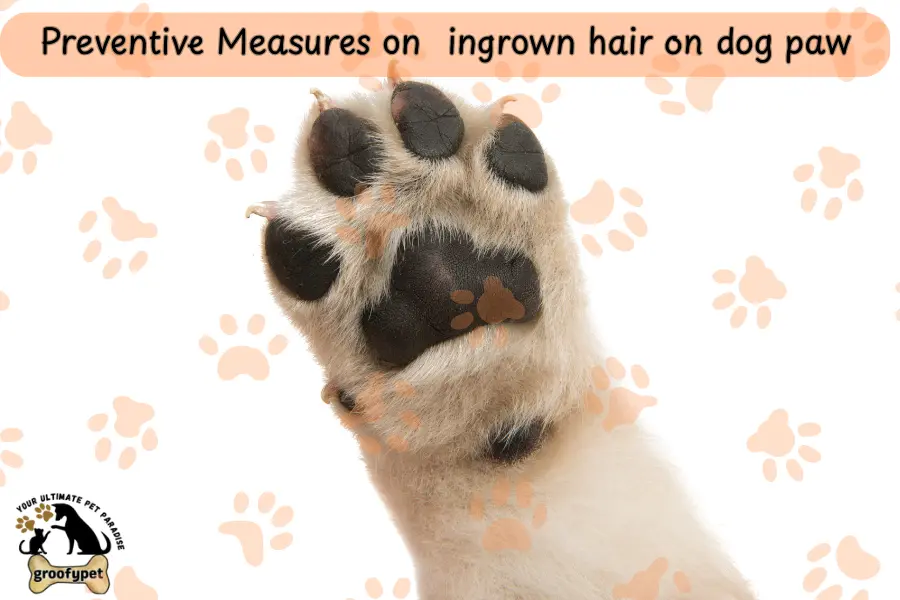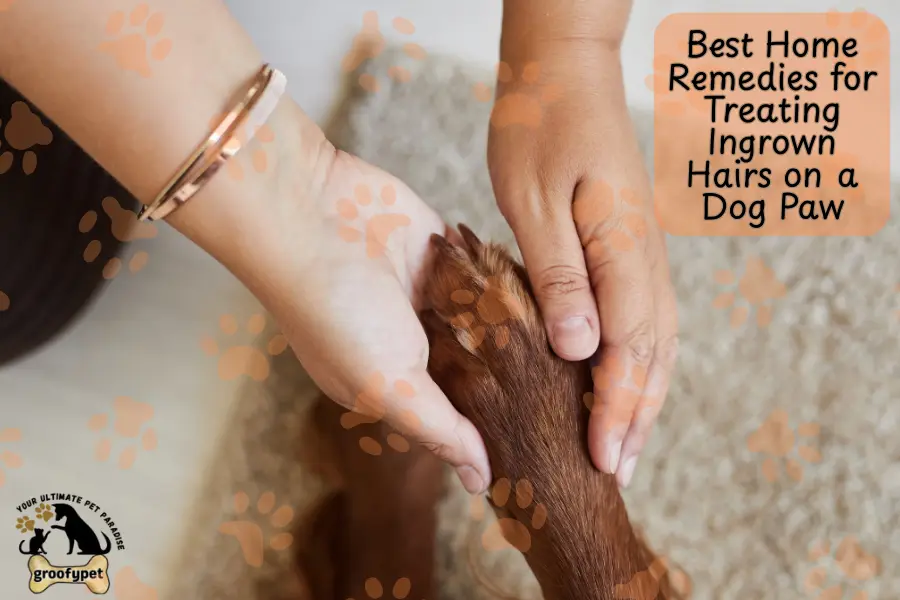
Ingrown hairs can be a prickly problem for dogs, and they can cause visible discomfort, especially when located on their paw pads or elbow calluses. These hairs are designed to shoot upwards from the hair follicle, but when they grow sideways, they become trapped under the skin, much like a rocket failing to launch The question is how to treat ingrown hair on dog paw ?
Impacted hair follicles are common in dogs, and while many people find satisfaction in watching videos about these issues on the internet, professional advice is always safer. The condition not only looks uncomfortable, but improper handling can worsen the problem. For a pet’s health, knowing what should we do and seeking expert guidance is key to providing relief.
Dogs are known for their active and playful nature but some health issues, like ingrown hairs, disrupt their health. Particularly common in paws, this condition goes unnoticed until it is visible discomfort. Although it seems like a minor issue, ingrown hairs cause swelling, pain, and even abscesses.This guide provides a comprehensive overview of recognizing, treating, and preventing ingrown hairs on dog paws. Identifying symptoms like red bumps, itching, and inflammation to explore effective treatment methods such as warm salt water soaks and antibacterial creams, you’ll learn how to alleviate your dog’s discomfort.
Additionally, it emphasizes preventive care, like regular grooming and avoiding close shaving, to minimize the risk of recurrence. By understanding the root cause and adopting proactive measures, you have to ensure your furry companion stays comfortable and healthy.
Let’s begin by exploring the symptoms of ingrown hairs, helping you detect this condition early and provide timely care to your dog.
Table of Contents
ToggleSymptoms of Ingrown Hairs on Dog Paw
Let’s begin by exploring the symptoms of ingrown hairs, helping you detect this condition early and provide timely care to your dog.

Red Bumps and Irritation
If you notice red bumps on your dog’s paw, it might be a sign of ingrown hair. These small, pimple-like spots appear due to trapped hair beneath the skin surface, irritating. I’ve seen this in my dog, where the bumps first looked like tiny pimples and quickly became inflamed. The hair growing back into the skin irritates the area, leading to a painful and swollen paw.
It’s important to catch this early so that you have to treat the irritation before it gets worse. Applying a warm salt water soak can help soften the area, allowing the trapped hair to eventually work its way out, relieving your dog discomfort. I recommend regular checks to ensure you’re on top of any changes, especially if your dog is excessively licking or scratching.
Itching and Chewing Behavior
When your dog has ingrown hair, they start itching, scratching, and even licking or chewing at the affected area. This constant attention to the spot creates the problem, leading to further discomfort and skin irritation. I’ve noticed this behavior in my dog when it develops a painful spot; his constant scratching only seems to make the irritation worse, exacerbating the issue.
To ease the discomfort, it’s important to address the cause right away, like soaking the paw in warm water, to reduce the irritation and calm your dog down. Immediate action can help prevent the situation from escalating and causing more significant issues.
Swelling and Tenderness
If ingrown hair dog paw becomes swollen and feels warm to the touch, it’s a sign of inflammation caused by ingrown hair. I’ve noticed that these symptoms occur as the body’s response to irritation or a minor injury, like when hair grows back into the skin. The area appears puffy, and your dog seems sensitive around the spot, avoiding putting pressure on the paw.
This can result in raised red lumps between the toes, which often sting like a rocket exploding. As a pet parent, spotting these can be worrying, and while the temptation to try DIY home treatments with tweezers is strong, it’s essential to handle the issue carefully.
In my experience, a warm saltwater soak helps to reduce the swelling and ease the discomfort. Acting early when you spot these signs prevents the condition from getting worse and causing pain for your dog.
Signs of Infection and Fluid Discharge
If you notice a discharge coming from the affected area on your dog’s paw, it’s a clear sign of infection. It happens when the ingrown hair irritates the skin too much, leading to a buildup of bacteria. When this happens, it’s important to clean the area gently, keep it dry, and consult a vet for proper treatment, untreated infections can last over time.
1-Identifying the Right Treatment Early
When dealing with ingrown hairs on your dog’s paw, recognizing the symptoms early is key to treatment. Observing signs of discomfort allows you to start the right treatment methods quickly, ensuring discomfort reduction and preventing more serious issues.
In my experience, addressing the problem as soon as you notice symptoms makes a big difference in how fast your dog recovers. By staying proactive and choosing the right care routine, you can avoid complications and keep your pet comfortable during the healing process.
Also Read : dog swallowed collagen stick
2-Best Care Practices and Treatment Methods
Dealing with ingrown hairs on your dog’s paws often requires home remedies and professional care. The approach you choose will depend on the condition, but a mix of tried-and-tested treatment methods work properly. For mild cases, effective home remedies like gentle soaking or moisturizing make a difference. However, when the condition is critical, it’s important to consult a professional to ensure your pet receives the right care.
This experience reminds me of the time my dog Max had an ingrown hair on his paw. While I initially tried home remedies, including warm compresses and gentle cleaning, his condition required veterinary care for proper healing. It taught me that every situation needs the right balance of expertise and patience to protect your dog’s comfort and health.
3-Soothing Solutions for Comfort
A simple effective method to treat ingrown hair on your dog’s paw is to use warm salt water. Gently soak a cotton wool pad in the solution and apply it to the affected area, which helps to soften the skin, reduce irritation, and encourage the trapped hair to come to the surface naturally.
Alternatively, Epsom salt soaks are excellent for decreasing swelling, minimizing inflammation, and promoting healing. Doing this regularly with a mixture of warm water and salts can provide great relief and accelerate recovery, making it a comforting routine for your furry friend.
4-Applying Topical Solutions
Using antibacterial creams or ointments is an essential step to prevent infections caused by ingrown hairs. Always apply these to the cleaned area as per the instructions to ensure effectiveness. If you prefer a natural approach, opt for organic shampoos infused with antibacterial oils, which not only help to cleanse the skin but also soothe irritation without relying on harsh chemicals.
These solutions are simple yet highly effective in providing relief and keeping your dog comfortable during the healing process.
Can dogs get ingrown hairs?
Dogs can indeed develop ingrown hairs, a common yet often overlooked skin condition that can cause discomfort and potential health issues for our beloved canine companions. These pesky hair follicle problems typically occur when a hair curls back or grows sideways into the skin, leading to inflammation, redness, and sometimes painful bumps that can become infected if left untreated.
Factors like dense fur, frequent grooming, skin allergies, and certain breed characteristics can increase a dog’s likelihood of experiencing ingrown hairs. Pet owners should watch for signs such as excessive scratching, visible bumps, localized skin irritation, or changes in coat appearance, which might indicate the presence of ingrown hairs.
Regular grooming, using appropriate brushes, maintaining a healthy diet, and consulting with a veterinarian can help prevent and manage this uncomfortable condition, ensuring your furry friend remains comfortable and maintains a healthy, irritation-free coat.
When to Seek Veterinary Help
If home treatments fail to improve the condition, it’s important to consult a veterinarian for expert advice. They may need to prescribe antibiotics to manage infection control or recommend specialized scrubs to help maintain cleanliness and prevent further issues.
In severe cases, surgical removal of the ingrown hairs dog paw is necessary to ensure your dog’s comfort and recovery. Seeking professional help at the right time can make all the difference in resolving the problem effectively.
How to get rid of ingrown hairs on dogs preventive measures
Taking consistent care of your dog’s paws can keep them healthy and free from ingrown hairs, which can cause an uncomfortable condition if ignored. I’ve learned that following practical steps helps to prevent these issues effectively.

For example, regular grooming and inspecting your dog’s feet during playtime or walks can make all the difference. By maintaining good hygiene and monitoring changes, you can address concerns early and ensure your furry friend stays happy and comfortable.
1-Maintain Regular Grooming
Keeping up with regular grooming is a game-changer for me in preventing ingrown hairs on my dog’s paws. I make it a point to brush his coat frequently to remove loose strands and stop them from curling into the skin.
When it’s time for a trim, I always avoid shaving his fur too closely since that can increase the risk of hairs becoming embedded. Instead, I use scissors or entrust the task to a professional groomer, whose expertise helps minimize the chances of this problem occurring.
2-Watch for Signs of Discomfort
It’s important to watch for signs of discomfort in your dog to detect any issues with ingrown hairs. If you notice constant licking or chewing, it’s a sign of irritation in your dog. I’ve found that by making it a regular habit, my dog’s paws produce redness, swelling, or other abnormalities. Keeping a close eye on your dog’s behavior will help you stay ahead of any paw issues.
3-Keep Paw Pads Moisturized
Keeping your dog’s paw pads moisturized is key to preventing ingrown hairs. Dry or cracked skin creates a favorable environment for irritation and hair to grow inward. I use pet-friendly moisturizing products to keep the skin supple and healthy, which helps in reducing the chances of hair becoming embedded.
It’s important to apply these products regularly to maintain smooth and comfortable paw pads for your dog. A bit of extra care in this area can go a long way in preventing discomfort and ensuring overall paw health.
| Step | Details | Tips for Effectiveness |
|---|---|---|
| Inspect the Paw | Gently check for swelling, redness, or a visible bump where the hair has grown inward. | Use a magnifying glass for better visibility. Ensure your dog is calm during the inspection. |
| Clean the Area | Wash the paw with lukewarm water and a mild antibacterial soap to remove dirt and bacteria. | Avoid using harsh chemicals that may irritate the skin further. |
| Apply Warm Compress | Place a warm, damp cloth on the affected area for 5-10 minutes to soften the skin. | Repeat 2-3 times daily to encourage the ingrown hair to surface naturally. |
| Use Tweezers Carefully | If the hair is visible, sterilize tweezers and gently pull out the hair without causing pain. | Do not dig into the skin if the hair is not visible; this may worsen the condition. |
| Apply a Soothing Balm | Use a dog-safe antibacterial cream or aloe vera gel to reduce irritation and promote healing. | Choose products free of artificial fragrances to avoid further irritation. |
| Prevent Licking | Place a protective cone or bootie to prevent the dog from licking the area while it heals. | Licking can introduce bacteria and delay recovery. |
| Monitor for Infection | Look for signs like pus, excessive swelling, or foul odor indicating infection, and consult a vet. | Early intervention can prevent severe complications. |
| Trim Paw Hair Regularly | Trim the hair between the paw pads to reduce the chance of future ingrown hairs. | Use pet-safe grooming tools and keep the area dry to avoid matting. |
Best dog ingrown hair home treatment
Ingrown hairs lead to discomfort and infections in dogs in sensitive areas like paws. Here are effective home remedies to treat this condition.

1. Epsom Salt Soaks
Purpose: Remove impurities and reduce swelling.
Method: Warm water mixed with Epsom salt and soak the affected paw for about 10-15 minutes. Cleansing with Antibacterial Solution
Natural Shampoo: Use organic shampoos like aloe vera and antibacterial essential oils, oregano, and tea tree oil to clean the area.
Apple Cider Vinegar (ACV) Soak: Mix 1 cup of organic ACV in warm water and soak the paw for 30-60 seconds to reduce infections. ACV is good due to its antimicrobial properties.
3. Foot Powder Application
Homemade Powder: Combine ground organic oats or Bentonite clay with a few drops of antibacterial essential oils. Apply this powder between the toes to dry wounds and absorb moisture.
4. Paw Balms and Butters
Purpose: Protect and heal the skin due to its antibacterial properties.
Ingredients: Look for balms that are made from natural ingredients like beeswax, shea butter, or aloe vera. Apply to irritated areas.
5. Herbal Tea Rinses
Types of Teas: Chamomile, Echinacea, or goldenseal are used due to their anti-inflammatory properties.
Method: Mix several tea bags in a gallon of warm water and soak your dog’s foot for about 30 seconds.
6. Baking Soda Rinse
Purpose: Soothes inflamed skin and removes allergies.
Method: Mix 1-2 tablespoons of baking soda in a gallon of warm water and keep it for several minutes
7. Iodine Foot Soak
Purpose: Disinfects wounds and treats yeast infections.
Method: Prepare a warm iodine solution (tea-colored) and soak the affected paw for about 30 seconds.
8. CBD Salve
Purpose: Provides relief from inflammation and promotes healing.
Application: Use natural CBD salve specifically designed for pets, applying it two to three times daily on affected areas.
If home remedies do not improve your dog’s condition or if you notice signs of infection (like increased redness or discharge). Regular grooming and monitoring help to prevent ingrown hairs.
Also Read : french bulldog tear stains
Frequently Asked Questions
What causes ingrown hairs on a dog’s paw?
This happens due to improper grooming, excessive licking, or walking on rough surfaces.
How do I identify an ingrown hair on my dog’s paw?
Look red bumps, swollen or tender areas and signs of irritation like scratching or licking. Severe cases show discharge, like pus or fluid.
Is it safe to treat an ingrown hair at home?
It is managed by cleaning the area with antiseptic and keeping it dry. However, if you notice swelling, infection, or discharge, consult a vet.
What should I avoid when treating ingrown hairs?
Avoid to rub this area as this cause irritation and increase the risk of infection. Never use harsh chemicals on dog skin
How I prevent ingrown hairs in the future?
Regular grooming, trimming hair around the paws and keeping the area clean to help prevent ingrown hairs. Remove your dog habit of excessive licking.
When should I take my dog to a vet?
If you notice symptoms like swelling, discharge or your dog shows signs of discomfort, seek professional help to avoid complications
Final Thoughts
By following simple measures like regular grooming, moisturizing paw pads, and monitoring your dog’s behavior, you have to reduce the likelihood of ingrown hairs causing any issues. I’ve found that maintaining these habits not only keeps my dog’s paws healthy but also ensures he stays comfortable and happy. With consistent care, you can prevent discomfort and make sure your furry friend feels great, every step of the way.
Does Spaying a Dog Help With Potty Training? Surprising Benefits You Can’t Ignore!”
Can Dogs Eat Fish Cakes? Healthy Treat Ideas for Dogs!
How to Get Rid of Grey Hair on Dogs with Natural and Loving Care!



